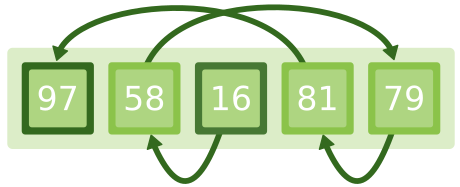CF843B.Interactive LowerBound
普及/提高-
通过率:0%
AC君温馨提醒
该题目为【codeforces】题库的题目,您提交的代码将被提交至codeforces进行远程评测,并由ACGO抓取测评结果后进行展示。由于远程测评的测评机由其他平台提供,我们无法保证该服务的稳定性,若提交后无反应,请等待一段时间后再进行重试。
题目描述
This is an interactive problem.
You are given a sorted in increasing order singly linked list. You should find the minimum integer in the list which is greater than or equal to x .
More formally, there is a singly liked list built on an array of n elements. Element with index i contains two integers: valuei is the integer value in this element, and nexti that is the index of the next element of the singly linked list (or -1, if the current element is the last). The list is sorted, i.e. if nexti=−1 , then value_{nexti}>value_{i} .
You are given the number of elements in the list n , the index of the first element start , and the integer x .
You can make up to 2000 queries of the following two types:
- ? i ( 1<=i<=n ) — ask the values valuei and nexti ,
- ! ans — give the answer for the problem: the minimum integer, greater than or equal to x , or ! -1, if there are no such integers. Your program should terminate after this query.
Write a program that solves this problem.
输入格式
The first line contains three integers n , start , x ( 1<=n<=50000 , 1<=start<=n , 0<=x<=109 ) — the number of elements in the list, the index of the first element and the integer x .
输出格式
To print the answer for the problem, print ! ans, where ans is the minimum integer in the list greater than or equal to x , or -1, if there is no such integer.
Interaction
To make a query of the first type, print ? i ( 1<=i<=n ), where i is the index of element you want to know information about.
After each query of type ? read two integers valuei and nexti ( 0<=valuei<=109 , −1<=nexti<=n , nexti=0 ).
It is guaranteed that if nexti=−1 , then value_{nexti}>value_{i} , and that the array values give a valid singly linked list with start being the first element.
Note that you can't ask more than 1999 queries of the type ?.
If nexti=−1 and valuei=−1 , then it means that you asked more queries than allowed, or asked an invalid query. Your program should immediately terminate (for example, by calling exit(0)). You will receive "Wrong Answer", it means that you asked more queries than allowed, or asked an invalid query. If you ignore this, you can get other verdicts since your program will continue to read from a closed stream.
Your solution will get "Idleness Limit Exceeded", if you don't print anything or forget to flush the output, including the final answer.
To flush you can use (just after printing a query and line end):
- fflush(stdout) in C++;
- System.out.flush() in Java;
- stdout.flush() in Python;
- flush(output) in Pascal;
- For other languages see documentation.
Hacks format
For hacks, use the following format:
In the first line print three integers n , start , x ( 1<=n<=50000 , 1<=start<=n , 0<=x<=109 ).
In the next n lines print the description of the elements of the list: in the i -th line print two integers valuei and nexti ( 0<=valuei<=109 , −1<=nexti<=n , nexti=0 ).
The printed structure should be a valid singly linked list. In particular, it should be possible to reach all elements from start by following links nexti , and the last element end should have -1 in the nextend .
输入输出样例
输入#1
5 3 80 97 -1 58 5 16 2 81 1 79 4
输出#1
? 1 ? 2 ? 3 ? 4 ? 5 ! 81
说明/提示
You can read more about singly linked list by the following link: https://en.wikipedia.org/wiki/Linked_list#Singly_linked_list
The illustration for the first sample case. Start and finish elements are marked dark. 